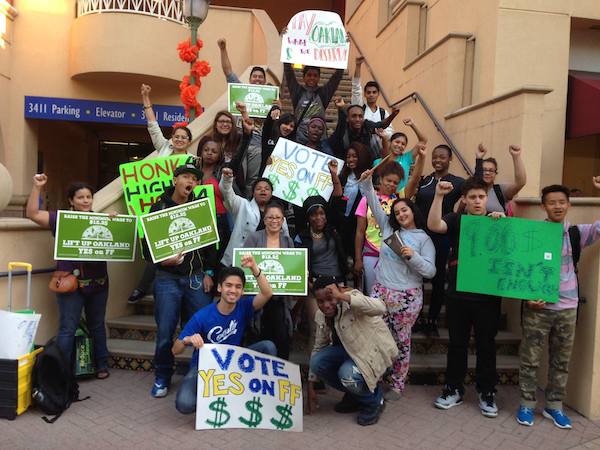How Personal Healing and Social Change can be Aligned for Transformative Movement Building by Nicole Lee

Originally published on April 15, 2015.
As an activist and youth organizer who deeply values the power of healing and transformation, I have come to see that too often, within our movement, “healing” and “social change” occupy two separate spaces that have little intentional relationship with one another. Some people work to help others heal from their trauma and transform themselves. Other people dedicate themselves to grassroots organizing and changing the social and economic policies that shape our lives. While each of these spaces is imperative to any serious effort to create social change and transform our society, sometimes it seems that only a few people work in both.
It’s not hard to understand why that might be the case. It is easy for someone focused on healing and inner transformation to argue that we can’t heal society’s ills until we first heal ourselves. And, on the other hand, it is easy for someone focused on organizing and systems change to argue that the world has huge and urgent challenges that won’t wait for us to heal ourselves. The problem arises when we don’t heal the emotional and psychological harm that has been caused by systemic inequality. This leads us to burn ourselves out and often replicate the very dynamics we are trying to stop, hurting ourselves and hurting each other. Fortunately, a third perspective is beginning to emerge – one that integrates healing and transformation with organizing and systems change.
One of the people that taught me deep and lasting lessons about the need for us to work at the intersections of healing and social justice — and about the need for Healing-Centered Youth Organizing — is a young woman named Rayna. When I met Rayna she was 16 years old and had already suffered more loss than some experience in their entire lives. When Rayna was just 18 months old, her mother fell victim to gun violence, shot while pregnant with Rayna’s younger brother. Her mother was put on life support so the baby could be brought to term, but she never recovered from her injuries. Then, when Rayna was about 12 years old, her father’s girlfriend was murdered and her uncle was killed on the street where she still lives today. As a teenager, Rayna lost countless friends and peers to violence. On her sixteenth birthday, she opened her front door and saw her childhood friend lying on the ground surrounded by a large group of people. A police officer had shot and killed him.
It was shortly after this that I first met Rayna. A friend encouraged her to join Silence The Violence (which would grow into Urban Peace Movement). Rayna tells us now that she was reluctant to come because, based on her experiences up to that point, she had trouble believing that peace was even possible. When her friend invited her, she thought our program would be “one of those places where you go and adults tell you that you are a bad person.” But thankfully — for her and for us — that is not what happened. Instead, she saw peers and adults working together, respecting each other, trying to find a path out of the vicious cycle of violence. Over time, she came to participate regularly. She attended community events and trainings. She went on retreats with us. And, within a matter of months she became one of our most committed young people. In Silence The Violence/Urban Peace Movement she found a new community of support, and in our trainings she learned skills and tools that she says “helped [her] calm down.” Outside of our meetings, she sought grief counseling. All of these things made a big difference in Rayna’s life. She began to open herself up to the possibility of happiness, daring to be vulnerable in the way that only a hopeful person can.

Based on this foundation of healing, Rayna entered into her first organizing campaign with our organization — a coalitional effort to secure a “community jobs agreement” for a large redevelopment project in Oakland expected to create thousands of new jobs.
After attending her first city council meeting, Rayna came back to our other youth and said something like, “did you guys know that there’s a room over there where a group of people decide about things that affect our lives, like what the police can or can’t do and what type of jobs are going to come to this city?”
During the campaign, Rayna discovered she had a knack for public speaking and the ability to quickly understand complex public policy arguments. She got up at that first city council meeting and gave a two minute testimony so powerful that the council president actually interrupted the next speaker to call Rayna back up to the podium. He then paused the meeting to thank her personally for her remarks.
Rayna emerged as one of the lead spokespeople for the Campaign for Quality Jobs. Our coalition, Revive Oakland, ended up winning a landmark jobs policy providing for a community-based job center, living wages, protections for formerly incarcerated workers, and local hire, among other things.
Through the campaign, Rayna learned that her voice could help shift Oakland’s trajectory. And if her voice was powerful enough to change the course of local history, it could also transform her own life. Rayna landed a job shortly thereafter and she literally walks taller now than before. It was community organizing that gave her back to herself, helping her rediscover that which she had lost touch within all her trauma. She found her voice and her own power through organizing, and that is a critical part of the healing process.
Today, Rayna is a powerful, dynamic, self-assured young woman. Like most young adults, she is still finding her way. But she has a sense of confidence and conviction that sets her apart. Working with Rayna has been a pleasure and a privilege, and I wish that I could take credit for the person she has become and is becoming, but she did it herself. All we did was create the space for her leadership to emerge. In return, she has reminded me time and time again of why I fell in love with the power of organizing in the first place. And she has reinforced an important lesson: organizing and healing are not separate or competing things. They are intricately bound together, and together they will help us achieve the freedom we know is possible.
One of the most well known passages from the bible reads, “the first shall be last, and the last shall be first.” Most often, this passage is interpreted to mean that those who have had the least access to opportunity and those who have been cast out to the margins of our society will eventually be the ones that lead. This is a very powerful interpretation that runs consistent with social justice theory. However, I have come to see that this passage may hold another simultaneous meaning.
In the conventional, materialist view of the world, we put things first and people last. We believed that if we had enough of whatever it was that we thought we needed (money, fame, status, etc.) then it would make us out to be better people. That turned out not to be the case. Another view is emerging which says that we should start first by paying attention to who we are “being” and let who we are being guide our actions and our decisions. This will, in turn, help us to have a better society and a better world — one that benefits all of us. In this way we will put what was once first last and what was last first.
Social change organizations must start to take our role as “generators” of hope and optimism much more seriously. We must claim our victories, no matter how small, whether victories over violence and despair, personal victories, or political and economic victories. These seemingly small wins will help us build the momentum and capacity required to create a movement strong enough to restore balance to our society. Wins generate hope. And, hope carries with it a certain kind of momentum that adds a boost to our capacity to bring forth new possibilities and new realities into this world.
I don’t think of my own “practice,” my own healing, as something entirely separate from the social justice work that I am involved in. As much as possible I work to integrate them. And, over time, I have come to see that my social justice work has become part of my practice. I believe that the work of social change, the work of reimagining our world, is sacred.
For a fuller exploration of healing-centered youth organizing, read Nicole’s report available on the Urban Peace Movement website: Healing-Centered Youth Organizing: A Framework for Youth Leadership in the 21st Century.
Nicole Lee is a four-generation Oakland native, is the Executive Director of Urban Peace Movement (UPM), a grassroots racial justice organization in Oakland that builds youth leadership to transform the social conditions that drive community violence and mass incarceration. UPM has three leadership programs: DetermiNation Black Men’s Group for young Black men, Leaders in Training Program, a multiracial youth organizing program, and Lit Mob South County in Ashland/Cherryland.

